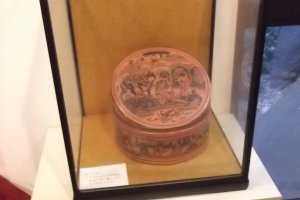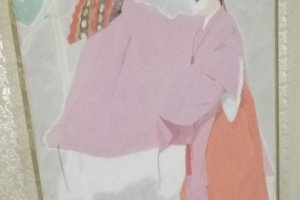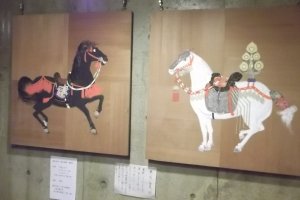Sometimes when I'm exploring a city, I like to find places to enjoy just by looking at street maps I find when I'm out walking around, and seeing what catches my eye. That's what I did one time with a map of Nagoya: my eye alighted on the long name of the Morimura Memorial Museum of Yamato-e (a traditional style of Japanese painting), which sounded at least worth going to take a look at. And I found it to be a delight: despite being in the middle of bustling Sakae, it's an utterly enchanting place, full of tradition and warmth.
Surrounded by blocky skyscrapers and parking lots, it's like a spot where modern Japan is being staunchly resisted. I walked down the narrow path, pulled aside the heavy wooden sliding doors, and stepped back about fifty or sixty years into the past. It's not only a museum, it's also the Morimura residence, and I was greeted by Morimura-san himself and his wife, a cheery, friendly elderly couple who speak a little English. (They'd introduce me later to a little girl who I suppose was their granddaughter: she was too shy to try out her English, despite their gentle encouragement, but was happy to exchange "konnichiwa"s and "genki"s.)
I was shown first to the tearoom, but I smacked my head on the ceiling trying to get in - "No, no, no" said Morimura-san - so I decided to go upstairs to look at the art before trying again. There's a small collection of paintings here, some painted by Morimura-san, some by his father, and there's also the studio and workshop where he continues to paint.
The paintings are hung around the walls and stairs, so it really is more a home with lots of art than an actual museum. I didn't know what the Yamato-e style of painting was: it seems to be very traditional and understated, with simple compositions and gentle colours. There are portraits against plain backgrounds, hanging scrolls with sparse images of natural scenes painted in ink, and also some display cases with beautiful Japanese and Chinese ceramics.
The main room downstairs is cosy and cluttered, with the warm atmosphere of a space that's used and lived in all the time. Morimura-san pointed out the exquisite painted ceiling, and four small, attractive animal paintings around the walls, one each on the north, south, east and west sides.
I had a second go at the tearoom, and this time did it right: first, scoot in backwards through the small, low entrance (clearly not designed for tall clumsy foreigners like me), then take the shoes off and slide in fully. It's a small, simply decorated space, used only for tea ceremony: there's a dedicated position for the host, and another for the guest, who sits in front of the alcove, traditionally adorned with hanging scroll and arranged flowers. Even though I wasn't having tea, spent a couple of quiet minutes there, sitting cross-legged on the tatami, savouring the calm.
The museum is open daily from Wednesday to Sunday, from 10:00am to 5:00pm. Admission costs ¥400 if you're not having tea, or ¥800 if you are, reduced to ¥600 for holders of the Nagoya Eco Kippu.



































